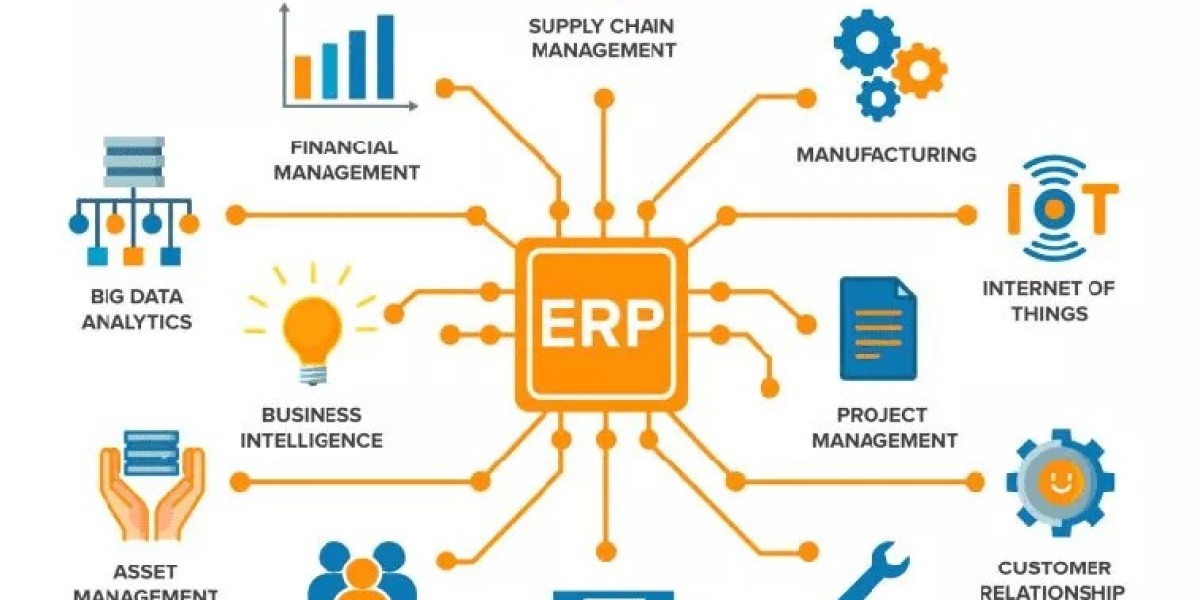In today’s fast-paced digital age, businesses need to stay ahead of their competition by optimizing internal processes and managing resources more effectively. Two essential technologies that help companies achieve this are Enterprise Resource Planning (ERP) and Human Resource Management Systems (HRMS) software. Together, these solutions streamline daily operations, improve communication, and drive smarter decision-making. This blog will explore the nuances of ERP and HRMS software, providing an in-depth understanding of their benefits, features, and how to implement them for success.
1. What is ERP Software?
ERP software is a comprehensive system designed to integrate and manage key business functions across various departments such as finance, sales, procurement, and production. By centralizing business data, ERP software allows for real-time sharing of information across the organization, promoting efficiency, and eliminating redundancies. Essentially, it acts as the nervous system of the business, connecting all parts to ensure smooth operations.
What makes ERP software particularly beneficial is its ability to offer a single source of truth for business operations. By maintaining data consistency and providing accurate insights, it helps companies make data-driven decisions. This real-time access to information means teams can work more cohesively, ensuring that departments like finance, inventory, and customer service are all on the same page.
2. Benefits of ERP Software for Businesses
The primary benefit of ERP software is that it enhances efficiency by automating various tasks that would otherwise require manual intervention. Automation not only reduces errors but also saves time, allowing employees to focus on higher-level tasks. Moreover, an ERP system helps businesses reduce operational costs by improving resource allocation and eliminating redundant workflows.
In addition, ERP software provides powerful analytics and reporting features, enabling businesses to forecast trends and identify potential areas for improvement. With accurate and actionable insights, decision-makers can optimize processes, improve product offerings, and enhance customer satisfaction. ERP systems also promote better compliance by standardizing business practices and ensuring regulatory requirements are consistently met.
3. What is HRMS Software?
HRMS software, on the other hand, focuses on streamlining the human resource functions of an organization. It manages everything from recruitment and onboarding to payroll, employee benefits, performance evaluation, and compliance. In today’s increasingly complex HR landscape, HRMS systems offer a centralized platform where HR teams can store and manage employee information while ensuring seamless communication between employees and management.
One of the key features of HRMS software is its self-service functionality, which allows employees to access their personal information, manage their benefits, and submit time-off requests without needing HR assistance. This not only saves HR staff time but also empowers employees, leading to a more efficient and engaged workforce.
4. Key Advantages of Implementing HRMS Software
Implementing HRMS software provides significant advantages, particularly for larger organizations that deal with extensive employee data. First, it automates routine tasks like payroll processing, performance tracking, and benefits management, allowing HR teams to focus on strategic initiatives such as workforce planning and employee development. Automation ensures greater accuracy and reduces the risk of human error, especially in critical areas like payroll.
Another advantage is the enhanced transparency and employee satisfaction that comes with HRMS software. With self-service portals, employees gain more control over their information, fostering trust in the organization. In addition, HRMS software offers analytics that helps HR teams track workforce trends, measure employee engagement, and make informed decisions regarding hiring, training, and retention strategies.
5. ERP Software Features Every Business Needs
ERP software is packed with features that help businesses manage their operations more effectively. Key features include financial management, inventory management, customer relationship management (CRM), and supply chain management. These modules help streamline workflows, improve collaboration, and enable businesses to achieve greater visibility over their operations.
Additionally, ERP systems offer built-in analytics and business intelligence tools that allow users to generate reports on everything from sales performance to production efficiency. This allows management to monitor KPIs and make informed decisions that enhance operational performance. Furthermore, modern ERP solutions often come with mobile access, ensuring that managers and employees can stay connected and productive, no matter where they are.
6. Must-Have Features in HRMS Software
HRMS software comes with several essential features designed to streamline HR processes and improve workforce management. Core features include recruitment, onboarding, payroll processing, performance management, and employee self-service. These functionalities help HR departments manage the entire employee lifecycle, from hiring to retirement, with ease and accuracy.
One critical feature of modern HRMS software is its ability to track compliance with local labor laws and regulations. Automated compliance tracking ensures that companies are adhering to necessary standards, reducing the risk of costly legal disputes. Moreover, integrated learning management systems (LMS) are increasingly being incorporated into HRMS platforms, enabling companies to track employee training and development, ensuring they remain competitive in their industries.
7. Cloud-Based ERP and HRMS: The Future of Business Operations
Cloud-based ERP and HRMS systems have gained popularity in recent years, offering a flexible and scalable alternative to traditional on-premise solutions. Cloud-based platforms allow businesses to access their systems from any location, offering greater flexibility for remote and distributed teams. This is especially valuable in today’s globalized workforce, where remote working has become the norm.
In addition, cloud-based systems tend to be more cost-effective as they reduce the need for expensive hardware and maintenance. With regular software updates and robust security features, businesses can ensure that their systems are always up-to-date and protected from cyber threats. The cloud also makes it easier to scale operations as the business grows, with the ability to add or remove users as needed.
8. Choosing the Right ERP and HRMS Software for Your Business
Selecting the right ERP and HRMS software can be a complex process, especially given the number of options available. When evaluating these systems, businesses should consider factors like scalability, ease of integration with existing systems, and overall cost. It’s important to choose a solution that aligns with the company’s specific needs and long-term goals.
In addition, businesses should assess vendor support and training capabilities. A well-supported system is critical for ensuring smooth implementation and ongoing success. Make sure the vendor offers comprehensive training to ensure that your team can leverage the software to its fullest potential. Flexibility and customization options are also key considerations, allowing businesses to tailor the software to their unique requirements.
9. Implementation Best Practices for ERP and HRMS Systems
Implementing ERP and HRMS software is a significant investment, and successful implementation requires careful planning and execution. Start by identifying clear objectives and involving all relevant stakeholders in the process. This ensures that the system meets the needs of each department and promotes cross-functional collaboration.
Conducting thorough training is also crucial to the success of the implementation. Employees need to be comfortable with the new system to fully leverage its features. Additionally, regularly reviewing system performance and gathering feedback from users can help identify areas for improvement and ensure continuous optimization of business operations.
10. Common Challenges Faced During ERP and HRMS Implementations
While ERP and HRMS software offer numerous benefits, their implementation can be challenging. One common challenge is resistance to change, as employees may be reluctant to adopt new systems. Overcoming this requires strong leadership, clear communication, and extensive training to ensure a smooth transition.
Another challenge is integrating the new software with existing systems. Businesses must ensure that the chosen ERP and HRMS systems can seamlessly integrate with their current technology stack to avoid data silos or disruptions in workflow. Working with experienced vendors or consultants can mitigate these issues and ensure a successful rollout.
11. ERP and HRMS for Small and Medium-Sized Enterprises (SMEs)
While ERP and HRMS software are often associated with large enterprises, small and medium-sized businesses (SMEs) can also benefit from these systems. Many vendors now offer scalable solutions designed specifically for smaller businesses, allowing them to automate processes, reduce costs, and improve efficiency without the hefty price tag.
By investing in ERP and HRMS systems, SMEs can level the playing field with larger competitors. These systems provide access to critical data and analytics, enabling business owners to make smarter decisions, improve employee satisfaction, and enhance customer service. For SMEs looking to grow, ERP and HRMS software are valuable tools for scaling operations efficiently.
12. Future Trends in ERP and HRMS Software
The future of ERP and HRMS software is driven by technological advancements such as artificial intelligence (AI), machine learning, and advanced data analytics. AI-powered ERP systems can analyze vast amounts of data and provide actionable insights, enabling businesses to forecast trends and make proactive decisions. Similarly, AI in HRMS can automate repetitive HR tasks and provide personalized employee experiences.
Another emerging trend is the use of blockchain technology in ERP and HRMS systems to enhance data security and ensure transparency in transactions and record-keeping. With continuous innovation, ERP and HRMS systems are expected to become even more integral to business operations, offering greater efficiency, predictive analytics, and enhanced user experiences.








